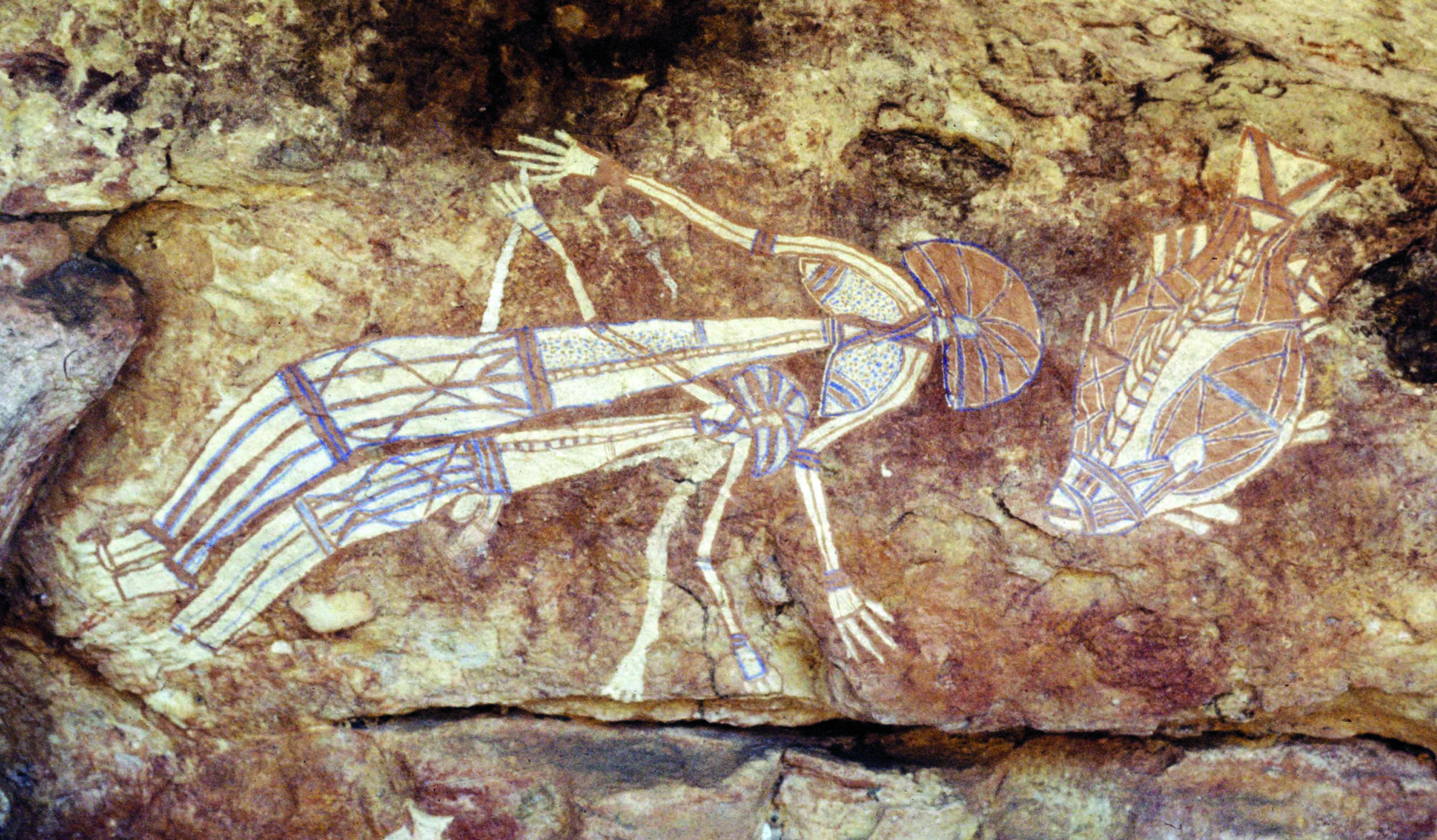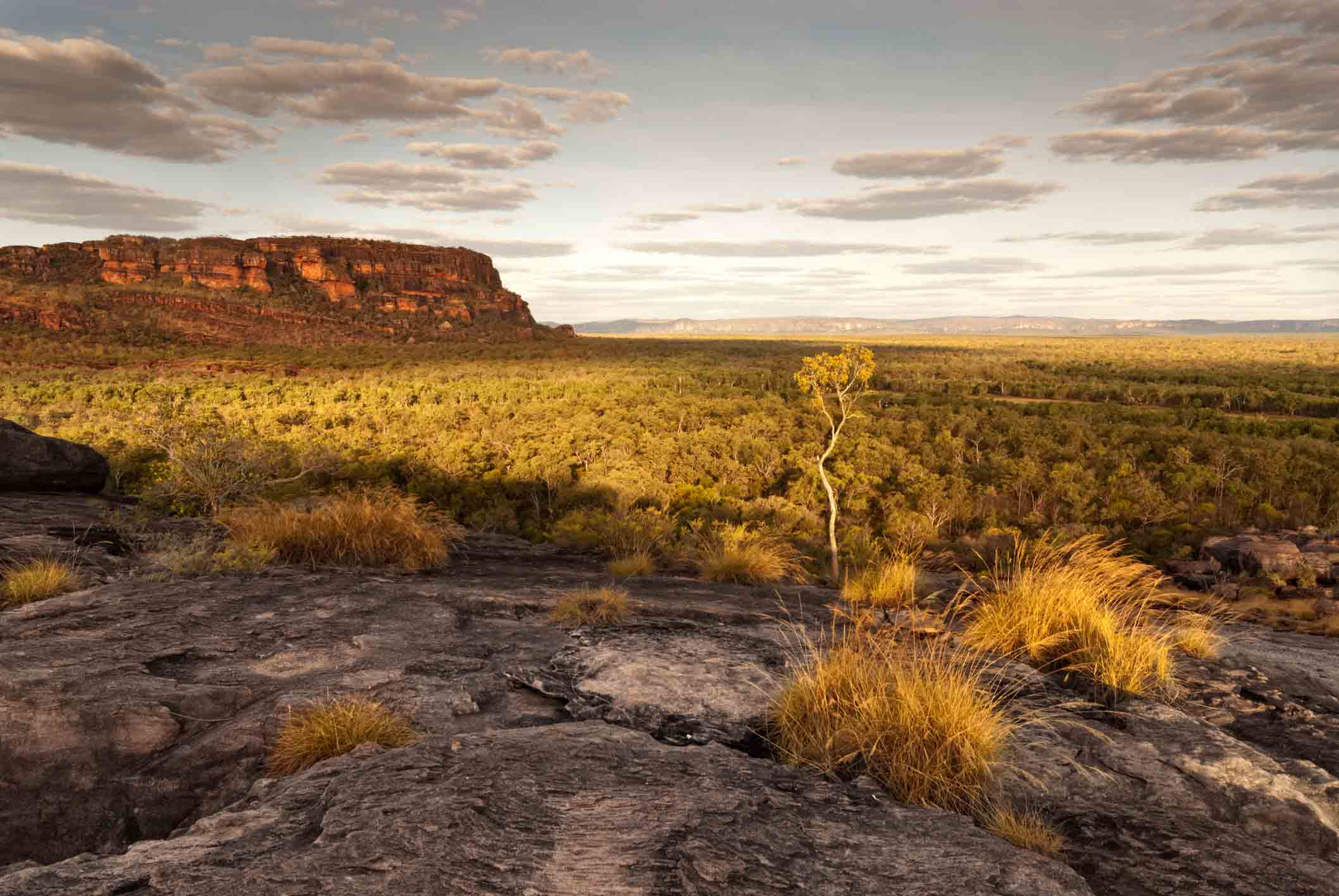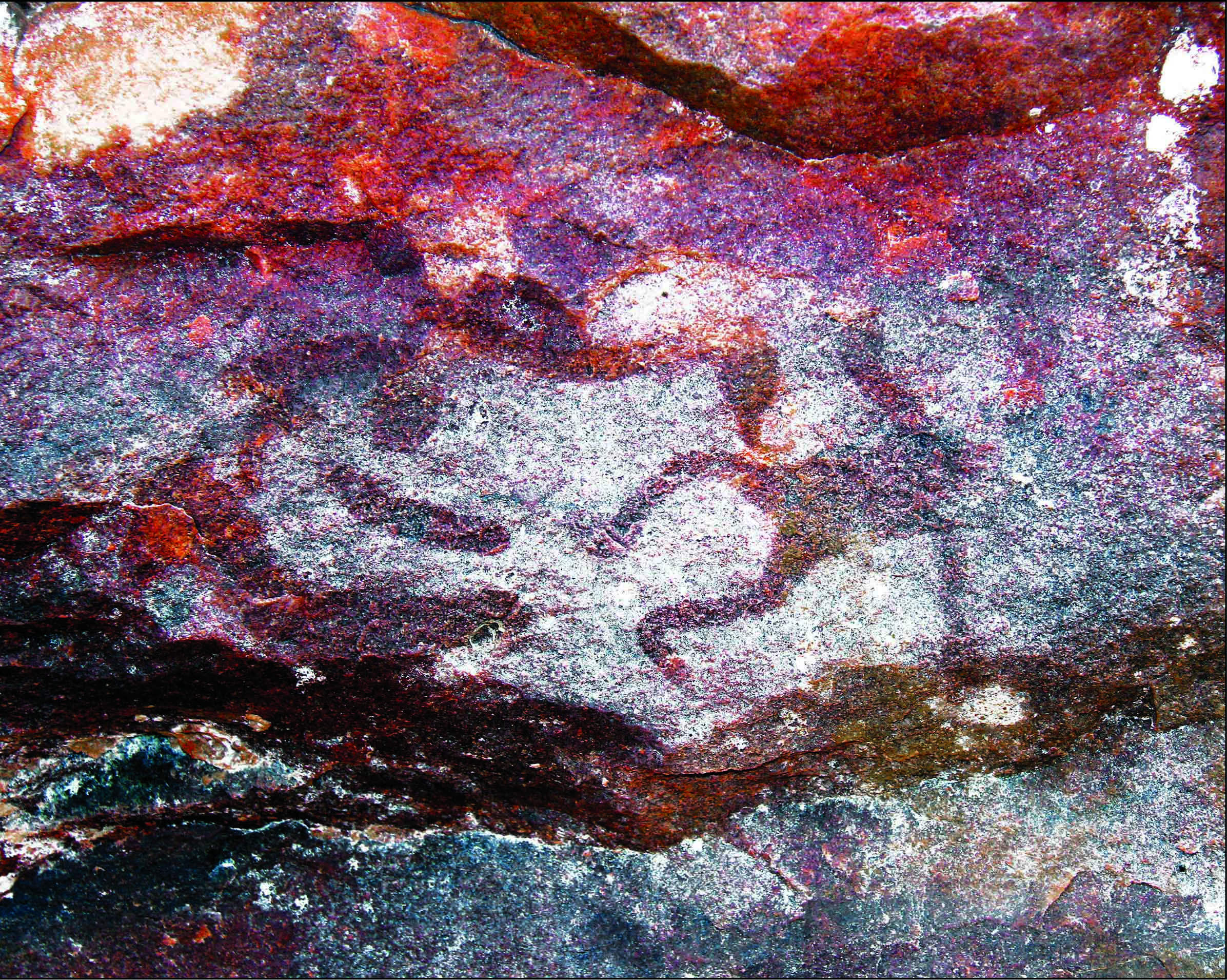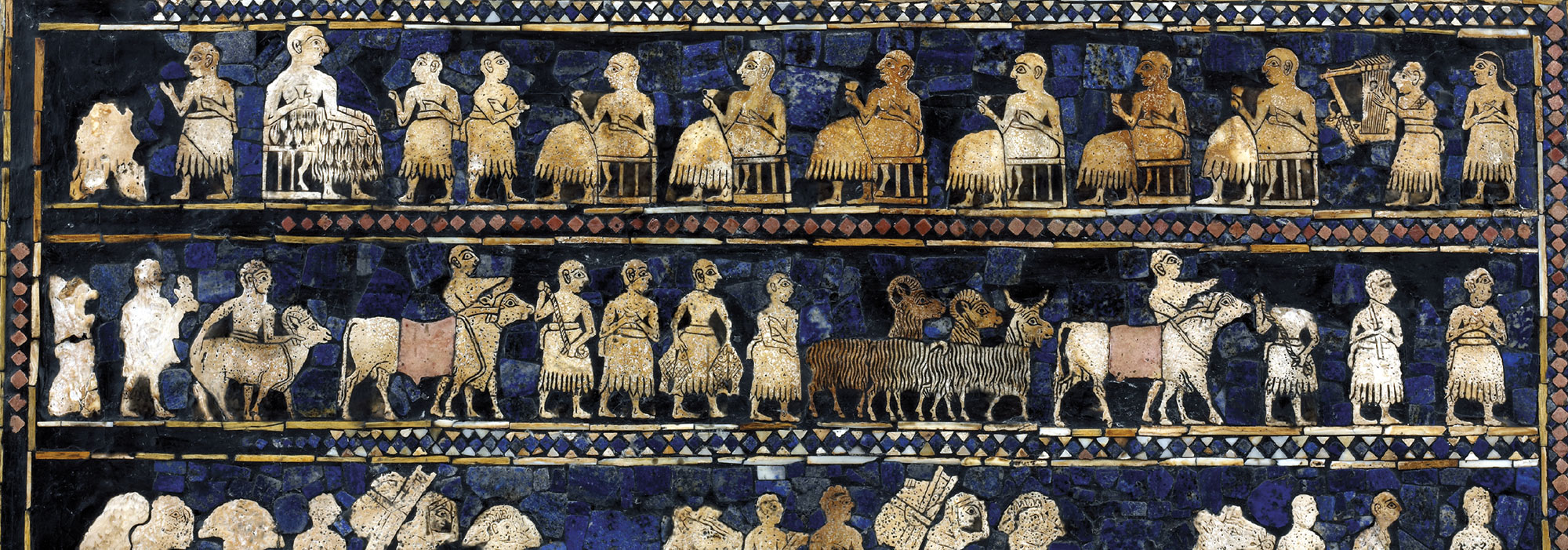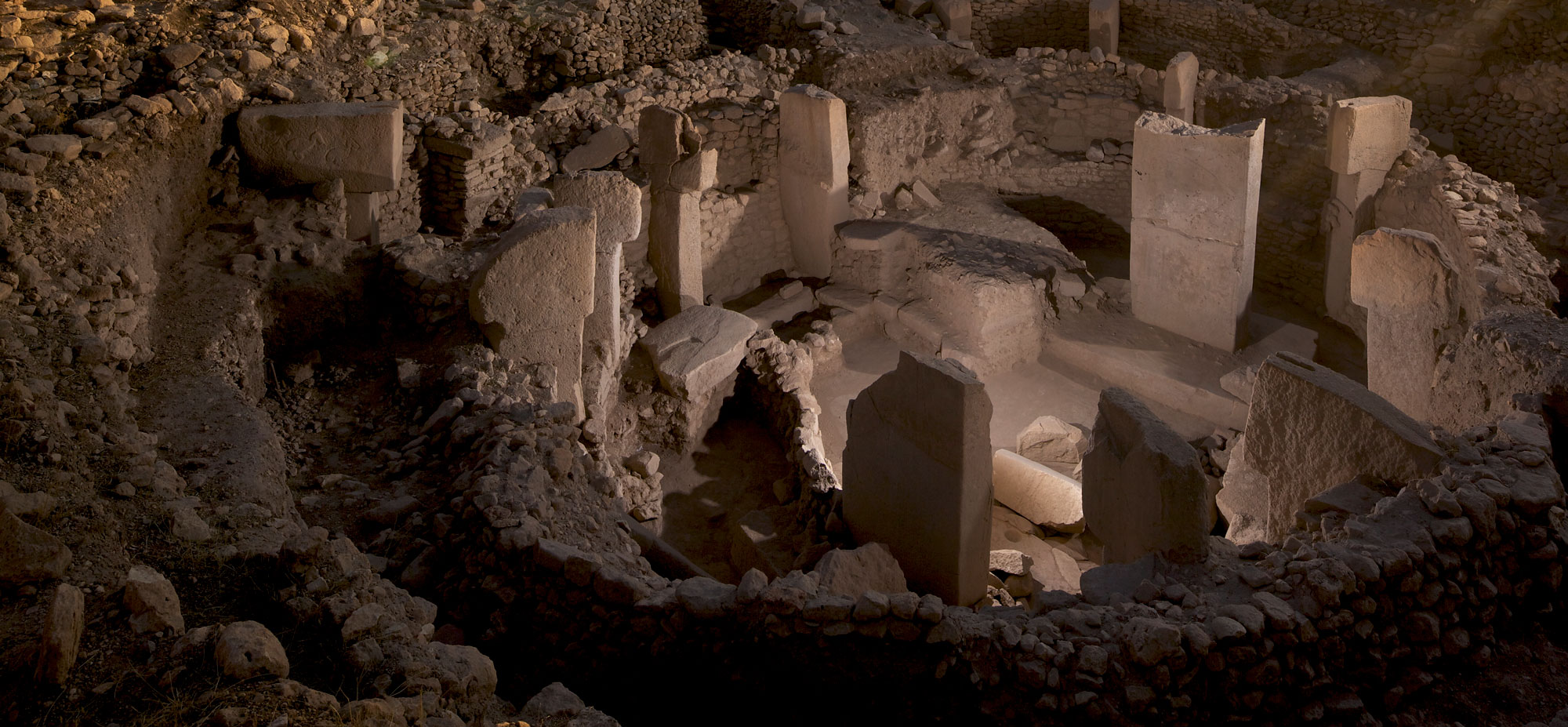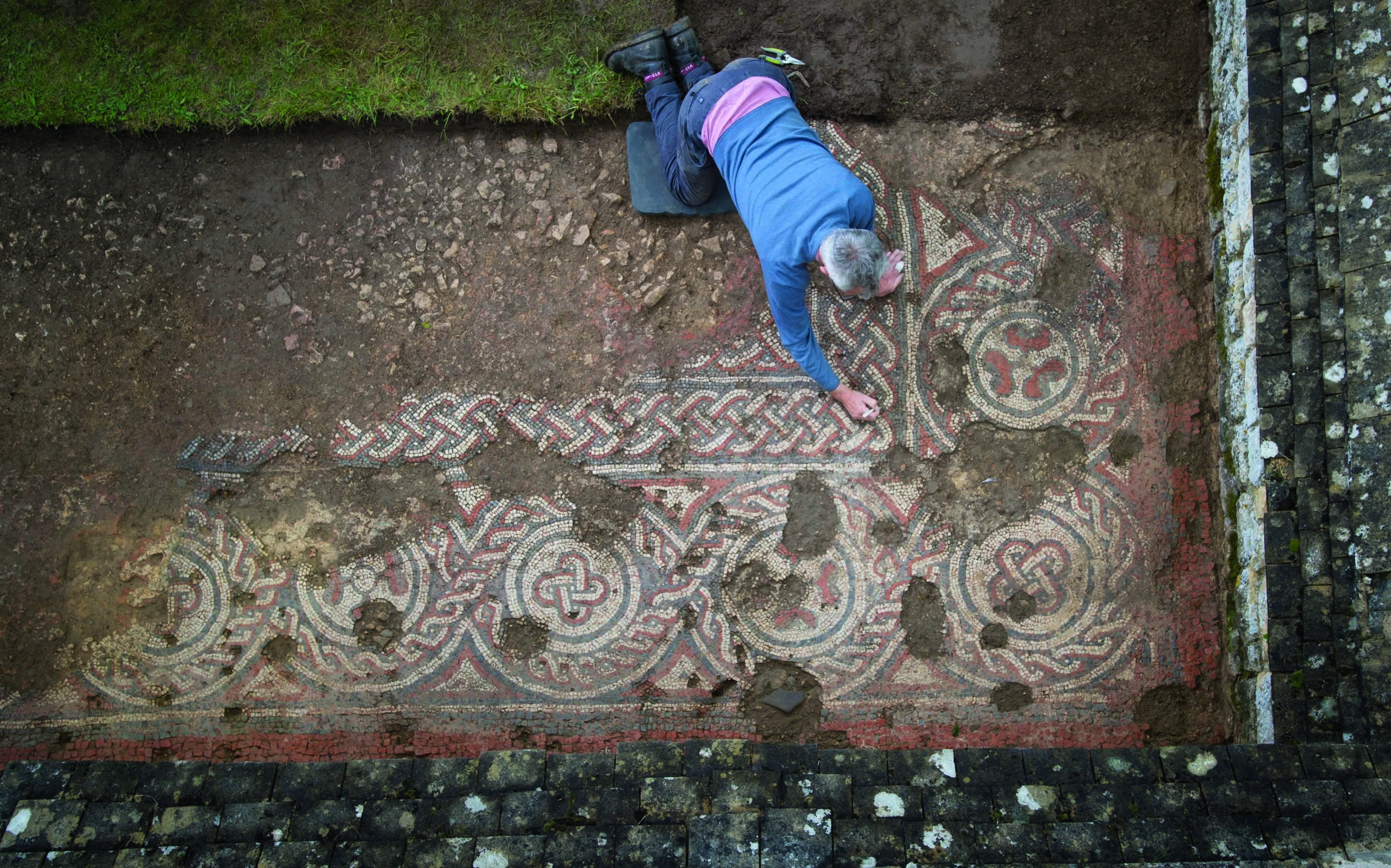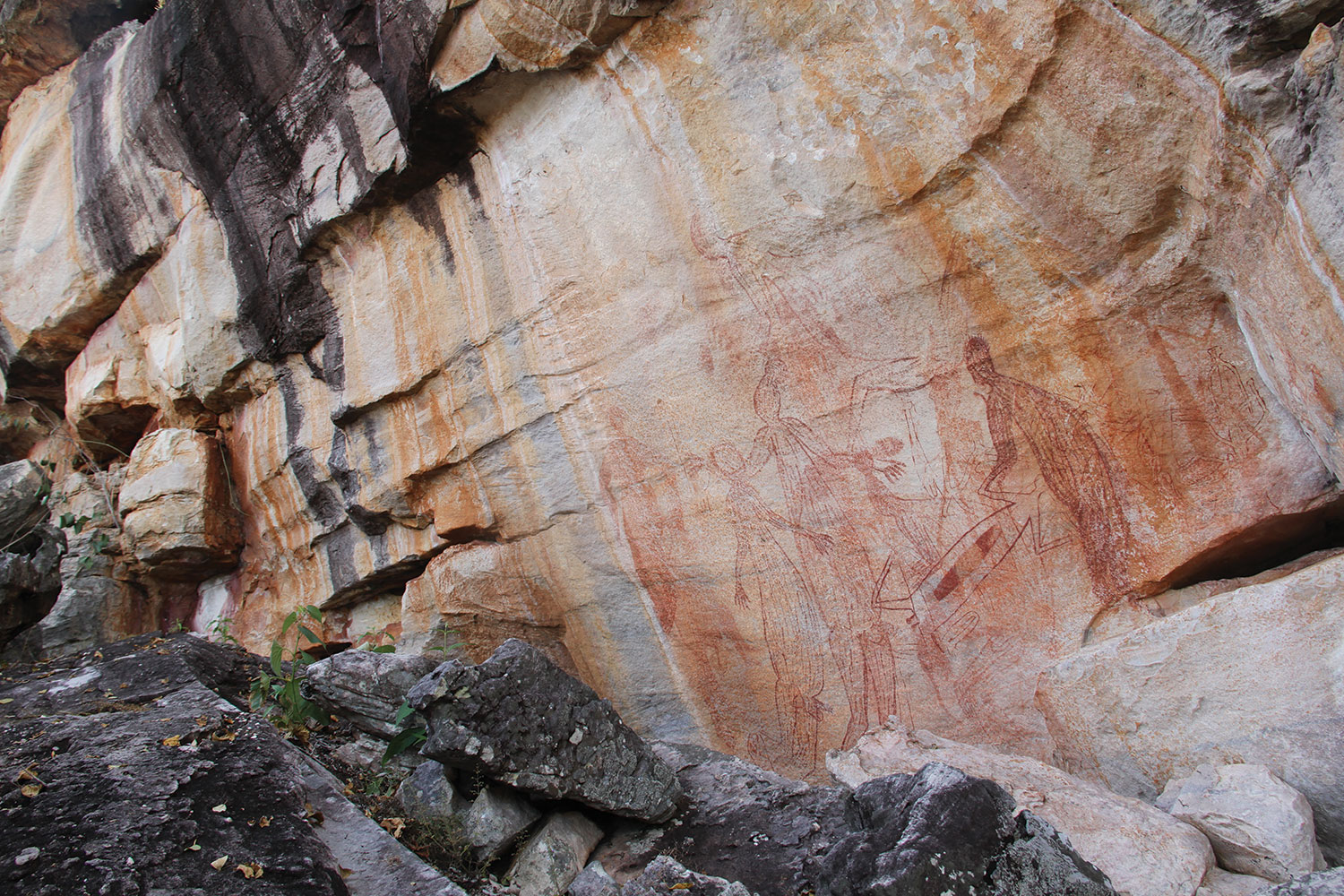
Along the northern coast of Australia’s Arnhem Land, the Alligator Rivers wind among towering sandstone outcrops, forming a maze of estuaries that eventually empty into the Timor Sea. Kangaroos hop alongside fish-filled rivers, through tropical savannas, and into thick forests of eucalyptus where dingoes, lizards, wallabies, pythons, and more than 100 species of birds make their home. Entwined with the natural landscape, evocative images of both animals and people painted on rocky crags and inside shallow caves appear as evidence of the region’s human past. West Arnhem Land is home to one of the world’s largest collections of rock art, a testament to the relationship between humans and nature that has thrived here since the Paleolithic era, more than 30,000 years ago. The region remains one of the most pristine and protected wilderness areas on the continent. Today, Arnhem Land is owned and managed by the nearly 12,000 Aboriginal people who call it their home, and whose vital contemporary culture is interwoven with the continent’s richest and longest archaeological record. This landscape is one of the only places in the world where modern Indigenous communities have maintained a millennia-old rock art tradition, preserving a storytelling practice that speaks of their history and culture, and of changes to the earth.
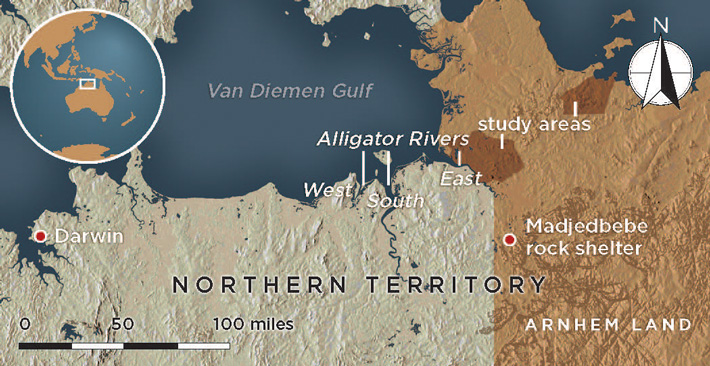
While the rock art of West Arnhem Land represents an artistic record spanning nearly 30,000 years, a 4,000-year stretch of this tradition had until recently eluded archaeologists studying and cataloging the colorful panels. The art from that period existed, researchers suspected, but was hidden amid a seemingly infinite variety of figures and styles. After years of survey and research in the territory, archaeologist Paul Tacon of Griffith University, along with a team of scholars collaborating with local Bininj, Mawng, and Amurdak Aboriginal people, thinks he has found this missing link in a newly identified style of rock art.
R. Lamilami, one of Tacon’s Bininj Aboriginal collaborators and a Traditional Owner in the area where the style is found, has named it the Maliwawa Style, referring to the area’s name in the local Mawng language. Tacon believes that the Maliwawa Style is the sought-after chapter in the history of the region’s rock art, and that it offers a fresh narrative about past climates and how people documented their lives as their environment rapidly transformed around them 10,000 years ago. “The recognition of the Maliwawa figures as a distinct style is important, as it lets us better see the transition between earlier and later paintings,” says Tacon. “The art, the associated stories, and the related practices would have allowed people to better cope with, and even embrace, change.”

The earliest evidence for people living in Australia is an assemblage of chipped stone artifacts and charred plant remains dating to 67,000 B.C. that was found in the Madjedbebe rock shelter located in West Arnhem Land. Butchered bones and plant remains from a variety of sites suggest that the first hunter-gatherers to arrive on the continent, having crossed a land bridge from Papua New Guinea, quickly adapted to Australia’s diverse landscape by harvesting resources from the sea, rivers, and inland desert. The distribution of sites across the landscape and tool assemblages found at these sites indicate that throughout the time people have lived in Australia, their lifestyles have often been dictated by the environment and weather. In the short term, people moved around seasonally in response to the yearly monsoons. In the longer term, hunter-gatherer groups exploited extensive swaths of territory during stable and drier conditions, but in episodes of climatic instability and increased precipitation, they commonly stayed closer to home, using rock shelters and caves as semipermanent dwellings. Although Arnhem Land contains thousands of documented archaeological sites, including camps, quarries, butchering sites, and stone tool production areas, there are nevertheless obstacles for researchers working to understand its history. Low amounts of soil accumulation coupled with intense seasonal flooding have made it difficult to date sites stratigraphically. And there is little variation in the styles of chipped stone artifacts over time, which stands in the way of accurate stylistic dating and of recognizing different populations who may have used a particular assemblage of tools. To help construct a more accurate narrative, researchers have turned to Arnhem Land’s rock art.
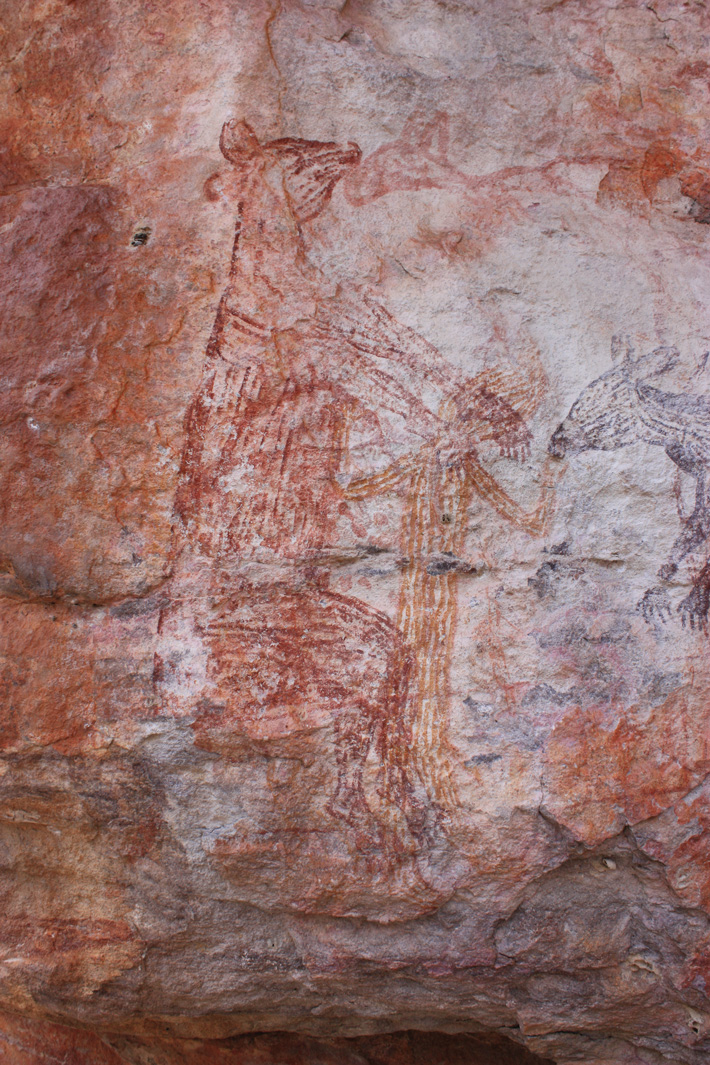
The oldest reliably dated rock art scenes in Australia are found in Arnhem Land and consist of animals sketched in charcoal that has been radiocarbon dated to about 30,000 B.C. Beginning with those very first depictions, rock art in Arnhem Land has provided insight into aspects of past ways of life that are not obvious through archaeological excavations. These include techniques for hunting with boomerangs and the process by which fish were caught and cleaned. Beyond offering a vibrant view of Arnhem Land’s deep past, the continuous evolution of rock art in the region has also allowed researchers to develop a chronology based on style and content. Such an investigation has required meticulous identification of the tens of thousands of figures and scenes that, in many instances, were drawn on top of one another.
Researchers have identified several main periods, including the Large Naturalistic Animals Style, which dates from about 16,000 to 11,000 B.C., and the Dynamic Style, which dates to between 11,000 and 8000 B.C. and is characterized by scenes of people using tools and interacting with the natural world. Then there appeared to be a four-millennium-long gap. Around 4000 B.C., Arnhem Land’s artists introduced floral motifs into their work, creating what is known as the Yam Style. Two thousand years ago, humans began to appear in different shapes than they had before, in the Simple Figures Style. Slightly later, artists started to display an intimate knowledge of anatomy and created what scholars have termed X-ray paintings, which depict the internal organs and skeletons of both humans and animals. This style has persisted into the modern day. The diversity of Arnhem Land’s rock art presents an unsurpassed resource for studying ancient people in northern Australia—but until recently, no style had been found that dated to between 8000 and 4000 B.C.
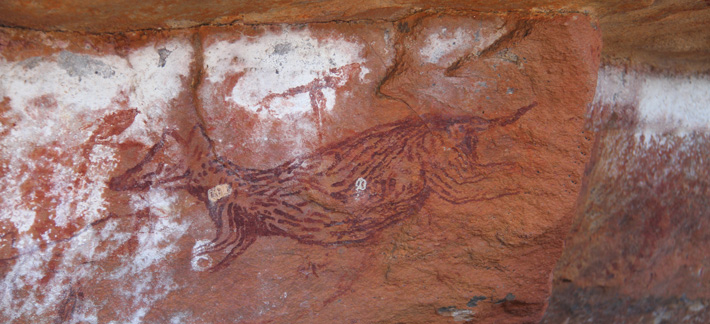
During an eight-year survey of rock art near West Arnhem Land’s Wellington Range, Tacon’s team made a startling discovery: rock art panels depicting large humans and animals in poses and in relationship to each other that were unlike anything they had seen before, despite decades of fieldwork in the region and nearly 80 years of other research efforts preceding theirs. As the team continued surveying sites spread over 80 miles, they identified 572 Maliwawa Style figures. “It was really exciting to find previously undocumented shelters with lots of Maliwawa figures on walls and ceilings, sometimes in scenes,” Tacon says. “When we saw these paintings for the first time, there was a rush of adrenaline, much excitement, cheering, and lots of shouts to each other.”
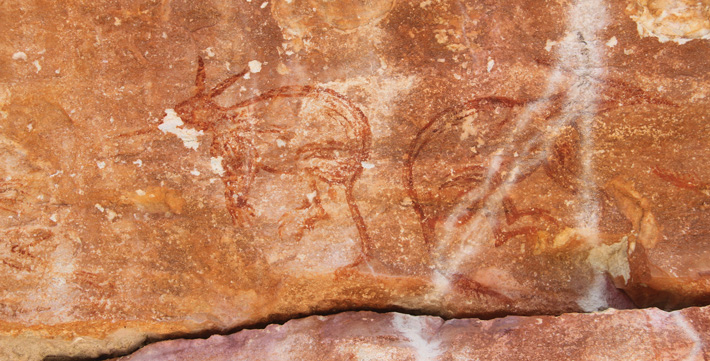
Painted in red and mulberry ochre with stroke-line infill, a technique in which artists fill in the interior of figures with parallel lines, the oversize Maliwawa Style figures showcase people in dreamlike floating poses, human figures with kangaroo heads, and an extraordinary variety of animals, including snakes, kangaroos, birds, desert-dwelling marsupials called bilbies or bandicoots, marine mammals related to manatees called dugongs, and thylacines, or Tasmanian tigers, which went extinct on the Australian mainland around 2,000 years ago. In many scenes that emphasize the relationship between people and animals, the animals seem to be the focus and appear as if they are watching the human figures. In one particular scene, a man wearing a headdress reaches out to an emu-like bird on his left and a half-human, half-kangaroo creature on his right. “This arrangement suggests transformation from kangaroo to human, a feature of many works of art documented in West Arnhem Land,” says Tacon. “Human-animal connectedness is represented here in a very strong way.” In addition to offering a distinctive perspective on human relationships with nature, some of the newly identified Maliwawa Style scenes appear on top of Dynamic Style figures and under Simple Figures Style drawings, perfectly filling in the 4,000-year gap in West Arnhem Land’s artistic history. At long last, archaeologists could learn more about life in this part of Australia between 8000 and 4000 B.C.
When the earliest Maliwawa Style scenes were painted around 10,000 years ago, northern Australia was in the midst of a period when its climate and weather patterns were shifting. “The time of the Maliwawa Style scenes was one of transformation, with landscapes responding to climate change at the tail end of the last Ice Age and developing warmer and wetter conditions,” says Cassandra Rowe, a paleoclimatologist from James Cook University who has worked extensively in West Arnhem Land. From about 12,000 until 6000 B.C., the sea level increased rapidly and the coastline retreated up to 150 feet each year. As salt water encroached on the land, newly formed mangrove forests grew inland, and increased rainfall fed already swollen rivers.
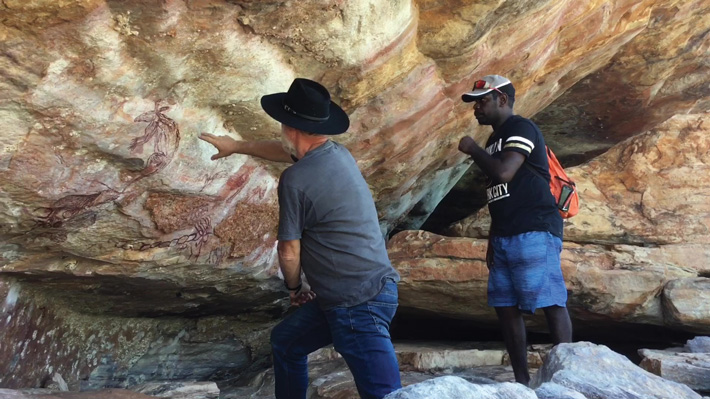
During this time, Maliwawa Style painters likely experienced unexpected interactions with animals that were venturing out of their typical ranges due to the changing conditions. A depiction of a dugong—the earliest known image of the species—possibly dates to a time when high sea levels would have allowed the animals to venture much farther upriver than would be possible today. Similarly, the prevalence of snakes in Maliwawa Style scenes might be explained by greatly increased rainfall and encroaching salt water pushing the reptiles out of their holes and into more frequent encounters with people. Unlike many styles of rock art that portray events through a human-centric view, the Maliwawa Style depictions of interactions between animals and people from the animals’ perspective reveal a subtle yet powerful message, as if suggesting that every living thing in West Arnhem Land was equally impacted by the transforming world.
As the sea level began to stabilize around 5000 B.C. and increasingly frequent monsoons unleashed even more precipitation on Arnhem Land, the mangroves retreated and a mixed landscape of freshwater and saltwater environments formed near the coast. At the same time, a combination of savanna and forest developed farther inland. Beginning around 4300 B.C., the region experienced an arid period of decreased precipitation before settling into the subtropical climate it has today around 2000 B.C. The portrayal of several bilbies in Maliwawa Style scenes—the earliest known appearance of these mammals in the art of Arnhem Land—may correspond to the end of the style, when the landscape briefly became drier and allowed new animals to venture into the region.

While the many changes to the landscape following the Ice Age would have put pressure on the people of Arnhem Land, the transition also provided new opportunities. Rock art dating to a time just prior to the development of the Maliwawa Style depicts a noticeable shift from people using terrestrial to estuarine resources as they adapted to new environments. The identification of shell middens in the archaeological record further supports the idea that people relied on estuarine and floodplain resources throughout the period. Just as animals and ecosystems were pushed inland during the time when the Maliwawa Style paintings were made, so were people. Prior to 8000 B.C., rock art in Arnhem Land developed in a stylistically consistent way across the entire region. But after the climate changed and people moved farther inland and led less mobile lives, local styles began to develop. “Populations were becoming more regionally distinct, and this can be seen in the rock art across West Arnhem Land,” says Tacon. “The emergence of a few regionally distinct styles of rock art in northern Australia, including the Maliwawa Style, reflects this.” By the time the last Maliwawa Style figures were painted around 4000 B.C., people’s way of life in Arnhem Land had been dramatically altered. These changes were reflected in rock art, and also may have inspired some Aboriginal creation stories that are still told today, 6,000 years later.
Throughout the entirety of their project, Tacon and his team have worked closely with Traditional Owners and Bininj Aboriginal collaborators to better understand the significance of the Maliwawa Style scenes. “By combining traditional knowledge with Western science we can take a two-toolbox approach to research that gives us more options and better outcomes for both the Indigenous and world communities,” says Tacon. In the course of the team’s work, several elders have explained that rock art acts as a community’s memory repository, depicting past experiences and tales that can be used to teach future generations. Lamilami and other Traditional Owners explain that the Maliwawa Style figures were made by their ancient ancestors to tell stories of their culture and experiences. “They told us that their sites are like books,” says Tacon, “and that large rock art sites are like libraries that hold the stories of all the people who lived and visited the area in the past.”

In addition to documenting people’s observations of animals encountered in the natural world, Maliwawa Style rock art depicts scenes related to the spiritual realm. Bininj Aboriginal elder Thompson Yulidjirri shared with the team that, in Arnhem Land, “art is not an end, but a gateway.” In this sense, it offers a venue to connect with spiritual beliefs, and in the case of the Maliwawa Style, to take viewers to the very beginning of time. During field surveys on which they accompanied Tacon and his team, several Aboriginal collaborators recognized that many of the Maliwawa Style scenes composed of floating people and human-animal hybrids represent depictions of the Dreaming, a period in Aboriginal belief systems when the world was created and spirits passed on information and values through art. “Some Maliwawa Style scenes seem to depict important Dreaming creation stories that are still important today,” says Tacon, “and aspects of the style, such as the back-to-back figures, are still painted in the context of important spirit beings. So the Maliwawa Style figures highlight long-term connections not only to the land, but also to the origin of key creation stories in a time of great change.” Some supernatural aspects of the scenes may relate to the dramatic shifts in the landscape and reflect a spiritual interpretation of a new physical world that was coming into being in Arnhem Land as a result of climatic events.
The discovery of the Maliwawa Style has helped fill an important archaeological gap in the history of West Arnhem Land and offers researchers an avenue to explore the intersection between spirituality and scientific inquiry among the crags and cliffs of northern Australia. As Tacon and his team prepare to continue working alongside Traditional Owners to further explore the connection between Maliwawa Style scenes and the region’s paleoclimate, they are noticing alarming changes to the ancient panels. Just as extreme weather once impacted West Arnhem Land and its people, it is doing so again today at an unprecedented scale. The team has documented that millennia-old rock art scenes, including Maliwawa Style figures, are being eroded by tropical cyclones that have become more frequent and intense as a result of modern climate change. “The landscape of Arnhem Land is resilient and highly adapted to extremes in essentially everything both long and short term,” says Rowe, “but that’s not to give the impression that this region can cope with current threats.” The next step for rock art researchers in West Arnhem Land is preservation, to ensure that the ancient panels will offer knowledge and guidance to future generations as they have done for millennia. At the same time, rock art in Arnhem Land is a living canvas, and new paintings will take the place of old ones that may have faded, commemorating events and messages from the present as they have done in the past.



